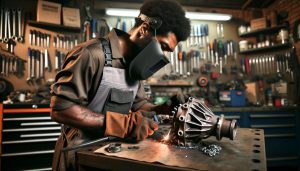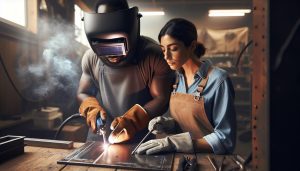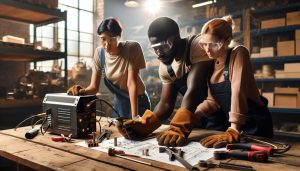When it comes to grilling, safety should always be a top priority. Did you know that welding gloves are not just for metalwork? They can significantly enhance your protection while barbecuing by shielding your hands from high temperatures and potential heat-related injuries. In this article, we delve into the benefits and effectiveness of welding gloves for BBQ enthusiasts, addressing common concerns and highlighting their unique features. As many food lovers seek to perfect their grilling techniques while ensuring safe practices, understanding the suitability of welding gloves can elevate your cooking experience. Whether you’re a seasoned pitmaster or a weekend griller, read on to discover valuable insights that could influence your next BBQ gathering.
Are Welding Gloves Safe for BBQ Use?
Using welding gloves for barbecuing can be a game-changer in terms of safety and usability. Many people might wonder about the appropriateness of these specialized gloves outside of welding conditions. Welding gloves are expertly designed to withstand high temperatures and provide excellent grip, which is crucial not only in welding but also in grilling scenarios. Their construction typically features materials capable of handling extreme heat, making them superior to many traditional BBQ gloves in certain respects.
When considering safety, it is essential to recognize that not all welding gloves are created equal. The primary concern is whether these gloves offer adequate dexterity and comfort for handling grilling tools and food. A proper fit is vital; while welding gloves can provide heat resistance-often rated between 932°F to over 1000°F-their bulkiness may impede fine motor skills required for tasks like flipping burgers or managing delicate food items. Therefore, selecting a pair designed with a balance between heat resistance and flexibility is crucial.
Another facet of safety worth mentioning is the material composition. Many welding gloves are made from high-quality leather or synthetic heat-resistant materials, which not only protect against burns but also against cuts and scrapes that may occur from handling hot or sharp objects. This added protection makes them an excellent choice for BBQ enthusiasts who often work with grill racks, hot pans, and various utensils. However, it is also important to be aware of their maintenance requirements; proper cleaning and care can prolong the life and functionality of these gloves, ensuring that they remain safe to use over time. Overall, welding gloves can indeed be safe for BBQ use, provided that they match the necessary safety and usability criteria for grilling tasks.
The Advantages of Using Welding Gloves for Barbecue
Using welding gloves for barbecue purposes can significantly enhance both safety and performance during grilling. These gloves are engineered to protect against extreme temperatures, making them an ideal choice for handling hot grills, coals, and cooking instruments. One of the key advantages of welding gloves is their construction from durable materials such as high-quality leather, which offers superior heat resistance, often rated up to 932°F or more. This feature ensures that users are shielded from burns and heat exposure that can occur when navigating around an active grill.
Furthermore, welding gloves are designed to provide exceptional grip and control. Their tactile sensitivity and grip-enhancing materials allow barbecue enthusiasts to handle tools, flip meat, and move pans with confidence, reducing the risk of drops or slips. Unlike typical BBQ gloves, which may be made from lighter materials, welding gloves can withstand not only heat but also cuts and abrasions. This added protection is essential in a barbecue setting where sharp utensils and hot surfaces create potential hazards.
Beyond their protective features, the versatility of welding gloves extends to various grilling methods, including traditional grilling, smoking, and even handling fiery logs in a fireplace. This adaptability makes them a valuable addition to any outdoor cooking toolkit. However, it’s crucial for users to select welding gloves that offer a good balance between flexibility and protection, as overly bulky gloves may impede dexterity when performing intricate tasks like marinating or skewering.
When integrated thoughtfully into your grilling routine, these specialized gloves can provide enhanced safety and usability, elevating your barbecue experience while keeping you protected from potential injuries.
Key Features of Welding Gloves That Enhance Safety
Welding gloves are purposefully designed to handle extreme conditions, making them an exceptional choice for barbecue enthusiasts. These gloves utilize materials that not only resist high temperatures but also provide robust protection against potential hazards one might encounter while grilling. For example, many welding gloves are crafted from high-quality leather or synthetic compounds that can withstand temperatures exceeding 932°F, ensuring the security of your hands while maneuvering around a hot grill or managing blazing coals.
A standout feature of welding gloves is their structure, which incorporates reinforced seams and a longer cuff design. This design element is not merely aesthetic; it enhances safety by ensuring that hot sparks, grease, and embers do not easily penetrate the glove. The extended cuffs offer additional coverage, reducing the risk of burns on the wrists and forearms during grilling activities. Moreover, some welding gloves include Kevlar stitching, which enhances durability, ensuring that the gloves maintain their integrity over extended periods of use.
Aside from heat resistance, the grip offered by welding gloves is a crucial factor that enhances safety while grilling. Typically featuring textured surfaces, these gloves allow for a better hold on cooking tools and hot items such as grates and pans. A secure grip is vital for preventing accidents, such as dropping sizzling meat or slipping equipment. Their flexibility, alongside thick padding, helps to absorb shocks and impacts, making them suitable for a variety of grilling tasks whether flipping burgers or removing a hot skillet from the grill.
It’s essential to consider these features when selecting gloves for barbecue use. While many might opt for traditional BBQ gloves, the comprehensive protective attributes of welding gloves make them a superior choice for serious grillers. In conjunction with their robustness, welding gloves are versatile enough to be used for other applications beyond grilling, making them a valuable addition to any outdoor cooking setup. Investing in a good pair of welding gloves not only elevates safety but also enhances the overall cooking experience by allowing users to focus on perfecting their barbecue techniques without the distraction of potential injuries.
Comparing Welding Gloves to Traditional BBQ Gloves
Welding gloves are often regarded as overkill for everyday grilling scenarios, but their unique design and material composition can provide significant advantages that traditional BBQ gloves may lack. For instance, welding gloves are engineered to withstand extreme temperatures-many are rated to resist heat up to 932°F, surpassing the typical heat resistance of standard BBQ gloves. This enhanced heat protection is particularly beneficial for grillers who frequently handle hot coals, grates, or large cuts of meat directly from the fire.
When evaluating the construction of welding gloves versus traditional BBQ gloves, several factors come into play. Traditional BBQ gloves often prioritize flexibility and dexterity for tasks like flipping burgers or handling skewers. However, while they may provide adequate heat protection, they frequently fall short in terms of overall durability and coverage. Welding gloves are typically made of thick, high-grade leather or fire-resistant materials designed not only for heat resistance but also for puncture and cut protection due to the rigors of welding tasks. The longer cuff design of welding gloves also adds an extra layer of protection to the forearms, shielding users from any errant sparks or hot grease, something that is often a vulnerability with shorter BBQ gloves.
Another crucial differentiator is grip and dexterity. While both types of gloves may feature textured surfaces for improved handling, welding gloves tend to offer a firmer grip, which can be essential when maneuvering heavy or unwieldy items on the grill. The thicker material provides excellent insulation against high temperatures while ensuring that users can maintain a secure hold on tools or food items. This enhanced grip can contribute to greater safety-reducing the chance of dropping hot food or encountering slips and spills during grilling sessions.
In summary, while traditional BBQ gloves fulfill their purpose in casual grilling contexts, welding gloves deliver a combination of superior heat resistance, enhanced durability, and additional protective features. For avid grillers looking to elevate their grilling experience while prioritizing safety, opting for welding gloves could be a wise investment. They not only protect against burns and accidents but also afford greater control for a more enjoyable grilling experience.
Best Practices for Using Welding Gloves While Grilling
Using welding gloves while grilling is not only a choice rooted in safety but also practicality. For those who enjoy handling heavy grilling equipment or managing high-heat situations, properly utilizing these gloves can significantly enhance the grilling experience. Here are some best practices to consider:
Ensure that your welding gloves fit properly. A snug yet comfortable fit is crucial for maintaining dexterity while providing adequate protection. Gloves that are too loose can reduce your grip and lead to accidents, while those that are too tight can impede movement. It’s advisable to try on different sizes and styles to find the best fit before your grilling session begins.
Before engaging with the grill, always double-check the condition of your gloves. Look for any signs of damage, such as burns, tears, or worn areas. Any compromise in the material can significantly decrease their effectiveness in protecting against heat and sparks. If you notice excessive wear, consider replacing them to ensure optimal safety levels.
While welding gloves excel in heat resistance, they also offer protection against cuts and punctures. When handling items like sharp skewers or heavy grates, be mindful of the added protection these gloves provide. Use them to grip items securely, reducing the likelihood of slips or injuries. Additionally, use the long cuff feature, which is designed to protect your forearms from hot splashes and errant coals.
When using any tools or heavy utensils, ensure you maintain a firm handle. The textured grip of welding gloves enhances control, so take advantage of this to stabilize items while flipping or moving them around the grill. This added grip is particularly beneficial when working with larger cuts of meat or while adjusting hot grates.
Cleaning your welding gloves is equally important. After grilling, shake off any debris and clean them according to the manufacturer’s guidelines. This may involve wiping them down with a damp cloth or carefully washing them with mild soap. Proper maintenance ensures longevity and reliability for your next barbecue.
Lastly, always exercise caution. Welding gloves are a fantastic tool, but they are not infallible. Avoid using them for tasks that involve extreme moisture or flame contact, and always remain aware of your surroundings while grilling. By adhering to these best practices, you can enjoy a safer, more effective grilling experience while leveraging the robust protective benefits of welding gloves.
Understanding Heat Resistance Ratings for Gloves
Understanding the heat resistance ratings of gloves is essential for anyone looking to enhance their grilling safety and efficiency. Heat resistance is typically measured in degrees Fahrenheit or Celsius, indicating the maximum temperature the gloves can withstand without degrading or allowing heat transfer to the wearer’s skin. Welding gloves designed for high-temperature processes excel under extreme conditions, making them suitable not only for welding but also for grilling tasks that involve direct contact with hot surfaces.
Most welding gloves will feature specific heat resistance ratings provided by manufacturers, categorized into levels based on their performance in thermal exposure. It’s crucial to choose gloves that meet the requirements for the specific grilling tasks you plan to undertake. For example, gloves rated for up to 600°F (about 315°C) can handle tasks like flipping large cuts of meat or removing hot grates without compromising safety. Recognizing these ratings can prevent burns or other heat-related injuries while grilling.
When evaluating heat resistance ratings, consider the materials used in the gloves. Many high-performance gloves are made from materials like Kevlar, leather, or aluminized fabric, all of which provide different levels of insulation and durability. Leather, for instance, offers excellent protection against heat and sparks but may not be as effective in wet conditions, whereas synthetic materials might offer better flexibility and grip but could lack the high-temperature endurance of natural fibers. Additionally, gloves with reinforced seams and long cuffs provide added protection against splatters and prolonged contact with high heat.
Choosing the right gloves not only enhances personal safety but also improves the overall grilling experience. It’s advisable to match your glove selection to the type of grilling you engage in, whether it’s direct grilling over coal or indirect cooking techniques that require handling of different equipment and surfaces. Taking the time to understand heat resistance ratings and the materials involved can lead to smarter choices, ultimately ensuring a safer and more enjoyable barbecue experience.
What Materials Are Best for BBQ Safety?
When it comes to ensuring safety while grilling, the choice of materials used in gloves is critical. Welding gloves can offer not only superior heat protection but also resilience against the rugged outdoor environment associated with barbecuing. Key materials commonly found in welding gloves include leather, Kevlar, and aluminized fabric, each providing unique benefits that cater to grilling enthusiasts.
Leather
One of the most popular materials for grilling gloves is high-quality leather. Known for its exceptional durability and resistance to heat, leather can withstand high temperatures, making it ideal for handling hot grill grates, coals, or pots. Furthermore, leather provides a natural barrier against sparks and flames, ensuring a safer grilling experience. However, it’s important to choose gloves made from dry leather, as wet conditions can significantly reduce their protective capacity.
Keflar
For those looking for lightweight flexibility, Kevlar is another excellent material choice. Typically used in gloves designed for high-heat applications, Kevlar not only offers outstanding heat resistance but also extends durability against cuts and abrasions. This is particularly beneficial when handling sharp tools or heavy meats during preparation. Additionally, gloves embedded with Kevlar are often more breathable, helping to keep hands cool during extended grilling sessions.
Aluminized Fabric
Aluminized fabric is gaining traction among grilling professionals and amateurs alike. This material reflects heat, allowing it to withstand temperatures that can exceed 700°F (approximately 371°C), making it a superb option for those who frequently manage extreme heat while cooking. Notably, gloves made from aluminized fabric are often lightweight, providing both protection and ease of movement.
Choosing the Right Glove
When selecting gloves for barbecue safety, consider the following factors:
- Heat Rating: Look for gloves that specify a heat resistance rating suitable for grilling tasks.
- Grip: Opt for gloves that provide a non-slip surface, ensuring a secure hold on grilling tools and food items.
- Cuff Length: Longer cuffs can offer additional protection against splashes and heat exposure.
- Fit: Ensure the gloves fit well, as loose gloves can hinder dexterity and control while handling hot items.
By understanding the advantages of these materials and their respective properties, grilling enthusiasts can make informed decisions on the best gloves to use, significantly enhancing their safety and enjoyment during outdoor cooking.
User Reviews: Welding Gloves for BBQ Enthusiasts
Many grilling enthusiasts have discovered the benefits of using welding gloves for barbecue purposes, providing a level of protection that is often superior to conventional BBQ gloves. User reviews highlight their exceptional heat resistance and durability, making them suitable for high-temperature applications like grilling, where handling hot grates, coals, and heavy grills is routine.
Those who have made the switch to welding gloves often comment on their sturdiness. Reviewers appreciate not just the heat protection they offer, but also the enhanced grip and dexterity. Users frequently mention the effectiveness of leather and Kevlar combinations that allow for both flexibility and robust heat resistance. Many find that handling larger cuts of meat and navigating the grill becomes easier without the worry of burns, especially when it comes to reaching into the grill for adjustments.
Another common theme among reviews is that welding gloves, particularly those with longer cuffs, provide better protection from splashes and radiant heat when compared to traditional BBQ gloves. This feature allows users to feel more secure while managing grill flare-ups or when reaching into deeper grills. Buyers often highlight how well these gloves withstand rugged outdoor conditions – resistant to both heat and sparks, they appear to hold up well even after multiple grilling sessions in unpredictable weather.
However, while many users rave about these gloves, some also offer words of caution. A few have noted that some welding gloves can be bulkier than expected, which might reduce dexterity for very intricate tasks like flipping small items or manipulating grill tools. Therefore, trying on different styles or opting for gloves with a snug fit is advisable to ensure complete control while grilling.
Common Misconceptions About Welding Gloves and BBQ
Welding gloves are often misunderstood in the context of barbecue use, leading to several common misconceptions that can affect safety and performance. One prevalent belief is that all welding gloves are too cumbersome for grilling, preventing proper dexterity for tasks such as flipping burgers or adjusting grill settings. However, many high-quality welding gloves are designed with flexibility in mind. For example, gloves featuring a combination of leather and Kevlar allow for movement while still providing excellent protection against heat. Users can enjoy both safety and functionality when selecting the right pair.
Another misconception is that welding gloves are designed solely for extreme heat exposure and are unsuitable for different grilling scenarios. In fact, many welding gloves are engineered to withstand high temperatures while also being effective against splashes and sparks, making them quite versatile. They can be ideal for scenarios beyond simply flipping meat, including managing hot grates or coals. A significant advantage is their longer cuffs, which not only protect the forearms but also add an extra layer of security against unexpected flare-ups-a feature traditional BBQ gloves may lack.
Some grilling enthusiasts may mistakenly believe that welding gloves are a one-size-fits-all solution. The truth is, just like any protective gear, achieving the right fit is crucial for effective use. Ill-fitting gloves can impede movement, which is counterproductive when trying to maneuver around a hot grill. Trying on various styles and paying attention to the stitching and grip can help ensure that the gloves meet individual cooking needs while providing maximum safety.
Furthermore, while it’s essential to acknowledge that welding gloves are robust, it’s a misnomer to think they are indestructible. Regular cleaning and proper maintenance tutorials must be followed to preserve their integrity over time. Common misconceptions can lead to misuse, but awareness and education about these gloves’ specific features and limitations can ensure safe and enjoyable grilling experiences. By clarifying these misconceptions, BBQ enthusiasts can make informed choices that enhance their grilling adventures while prioritizing safety.
When Not to Use Welding Gloves for Grilling
When considering welding gloves for barbecuing, it’s crucial to recognize the scenarios in which their use might be inappropriate. While these gloves offer significant protection, there are specific limitations and conditions where they may not be the best choice.
Firstly, welding gloves, due to their construction and materials, can be bulkier than traditional barbecue gloves, which can hinder dexterity. For tasks requiring precise movements-like flipping delicate fish fillets or searing steaks in a pan-this reduced dexterity may pose a challenge. If you’re preparing a meal that demands intricate handling or quick adjustments, opting for gloves specifically designed for BBQ might be more advantageous.
Additionally, welding gloves are often designed for extreme conditions but may not be as breathable as BBQ gloves. This lack of ventilation can lead to heat buildup inside the gloves, causing discomfort or even heat-related injuries during prolonged grilling sessions, especially in warmer weather. Proper airflow is vital for comfort and safety, so consider switching to lighter gloves when grilling under such conditions.
Moreover, while welding gloves are excellent for protecting against high temperatures from hot grills or coals, they may not be ideal for dealing with sauces or marinades. The absorption of liquids can compromise the glove’s integrity, leading to weakened protection and potential burns. It’s wise to use traditional BBQ gloves for tasks involving direct contact with food substances, ensuring that your protective gear remains effective and hygienic.
In summary, although welding gloves can be a robust option for grilling, they are not suitable in every grilling situation. Assessing the cooking methods, food types, and environmental conditions will help determine the right gloves for your barbecue needs. Proper glove management is key to ensuring safety and enjoying a seamless grilling experience.
Expert Tips for Maintaining Your BBQ Gloves
Maintaining your BBQ gloves, especially when using welding gloves, is essential for ensuring their longevity and effectiveness. One key principle to remember is that these gloves are not only protective gear but also a vital component of your safety equipment while grilling. Proper care will help preserve their heat resistance and structural integrity, allowing for a safer grilling experience.
To start, always wash your welding gloves according to the manufacturer’s instructions. Most leather gloves can be cleaned using a damp cloth to remove any grease or food particles. It’s important to avoid soaking them in water or using harsh detergents, as this can deteriorate the material over time. For stains, a gentle soap solution can be applied with a soft cloth, followed by thorough drying laid flat to maintain shape.
Storage is another critical aspect of glove maintenance. After washing, ensure the gloves are completely dry before storing them to prevent the growth of mold or mildew. Keep them in a cool, dry place away from direct sunlight, as UV rays can cause the leather to crack and lose its protective qualities. Utilizing a glove rack or a designated storage box can help maintain their shape and prevent them from being crushed or damaged.
It’s also advisable to periodically check the gloves for any signs of wear or damage, such as cracks or thinning areas. If any part of the glove begins to show deterioration, it’s best to replace them to ensure continued protection. Regularly conditioning the leather with a suitable leather conditioner can also help maintain flexibility and prevent drying out.
Lastly, it’s essential to be mindful of the specific tasks when using welding gloves for grilling. While they are effective against high heat, they may not be designed for prolonged exposure to liquids or direct food handling. Keep a set of traditional BBQ gloves handy for handling marinades or cleaning, preserving the high heat protection that welding gloves offer without compromising hygiene or dexterity for intricate tasks. This dual approach ensures safety without sacrificing functionality in your grilling adventures.
Choosing the Right Size and Fit for Optimal Safety
Choosing the right size and fit for welding gloves is crucial, especially when considering their use for barbecue grilling. A poorly fitting glove can not only compromise safety but can also diminish the experience of handling hot grill items. Ideally, welding gloves should fit snugly around the wrist and hand, providing optimal dexterity while maintaining coverage. A common misconception is that looser gloves might afford better comfort; however, this often leads to reduced control and increased risk of burns or accidents.
To find the ideal size, it’s recommended that users measure both the length and width of their hands. Most glove manufacturers provide sizing charts that correlate hand measurements with glove sizes. When in doubt, opt for a size that allows slight movement but does not excessively bunch up at the fingers or wrist. Gloves with adjustable wrist straps can also enhance fit, providing both security and flexibility during use.
Key Considerations for Fit
When choosing welding gloves for BBQ use, bear in mind the following considerations:
- Material Flexibility: Gloves made from leather or high-quality synthetic materials generally offer better flexibility, allowing for more precise movements, which is essential when flipping meat or maneuvering grill tools.
- Length of Sleeve: Longer sleeves provide additional protection for the forearms, crucial when reaching into a hot grill. Consider gloves with longer cuff areas if you’re working with deep BBQ pits.
- Grip: Select gloves with textured palms and fingers for better traction. This will enhance grip on slippery utensils or hot grates.
- Heat Resistance: Always verify that the gloves can withstand the temperatures typically encountered at your BBQ, confirming their integrity against melting or burning.
Ultimately, investing in the proper size and fit of welding gloves not only enhances safety but also contributes to a more enjoyable and secure grilling experience. Ensuring that gloves are well-fitted allows for confident handling of hot items, promoting an overall safer cooking environment.
Frequently asked questions
Q: Are welding gloves suitable for grilling?
A: Yes, welding gloves can be suitable for grilling due to their high heat resistance and protective features. They protect hands from burns, splatters, and hot surfaces, making them a viable option for BBQ enthusiasts [1[1].
Q: What are the benefits of using welding gloves for BBQ?
A: The benefits include superior heat resistance, enhanced grip, and durability. Welding gloves are designed to withstand high temperatures, making them ideal for handling hot tools and grills, thus ensuring safety during BBQ sessions [2[2].
Q: How do welding gloves compare to traditional BBQ gloves?
A: Welding gloves generally offer better heat resistance and protection against sharp edges compared to traditional BBQ gloves. They are thicker and provide a firmer grip, making them more useful for handling heavy grilling equipment and hot items [3[3].
Q: When should you not use welding gloves for BBQ?
A: Avoid using welding gloves for BBQ when cooking with open flames for extended periods, as prolonged exposure can lead to the gloves retaining heat and potentially causing burns. Always monitor your equipment and ensure proper ventilation [2[2].
Q: What features should you look for in welding gloves for grilling?
A: Key features include heat resistance rating, length, flexibility, and material quality. Opt for gloves made from leather or fire-resistant fabrics that provide both protection and a good range of motion for ease of use during grilling [1[1].
Q: Can welding gloves protect against flames and sparks while grilling?
A: Yes, welding gloves are designed to protect against flames and sparks, offering excellent fire resistance. Their construction allows them to withstand light flames and hot embers, making them a safer choice when working around the BBQ [3[3].
Q: What are the common misconceptions about using welding gloves for BBQ?
A: A common misconception is that welding gloves are too rigid or bulky for effective use in grilling. However, many welding gloves are designed for mobility, allowing for easy handling of grilling tools while providing necessary protection [2[2].
Q: How should you maintain welding gloves used for BBQ?
A: To maintain welding gloves, clean them according to the manufacturer’s instructions, typically using a damp cloth for minor stains. Store them in a cool, dry place, and periodically check for signs of wear or damage to ensure ongoing protection during grilling [1[1].
Wrapping Up
In conclusion, while welding gloves can offer a substantial layer of protection during BBQ grilling, it’s crucial to consider their specifications and your cooking methods. Remember, choosing the right gloves not only enhances your safety but also maximizes your grilling experience. If you’re interested in exploring other grill gear that complements your welding gloves, check out our guide on essential grilling tools. Additionally, for insights on selecting the best welding techniques for various materials, you can refer to our detailed article on MIG and TIG welding processes.
Don’t let uncertainty hold you back from cultivating your grilling skills-equip yourself properly! If you have any questions or want to share your experiences with welding gloves at BBQs, leave a comment below. For more expert advice on safety protocols and equipment reviews, subscribe to our newsletter or explore our resource section. Your next great grilling adventure awaits!












